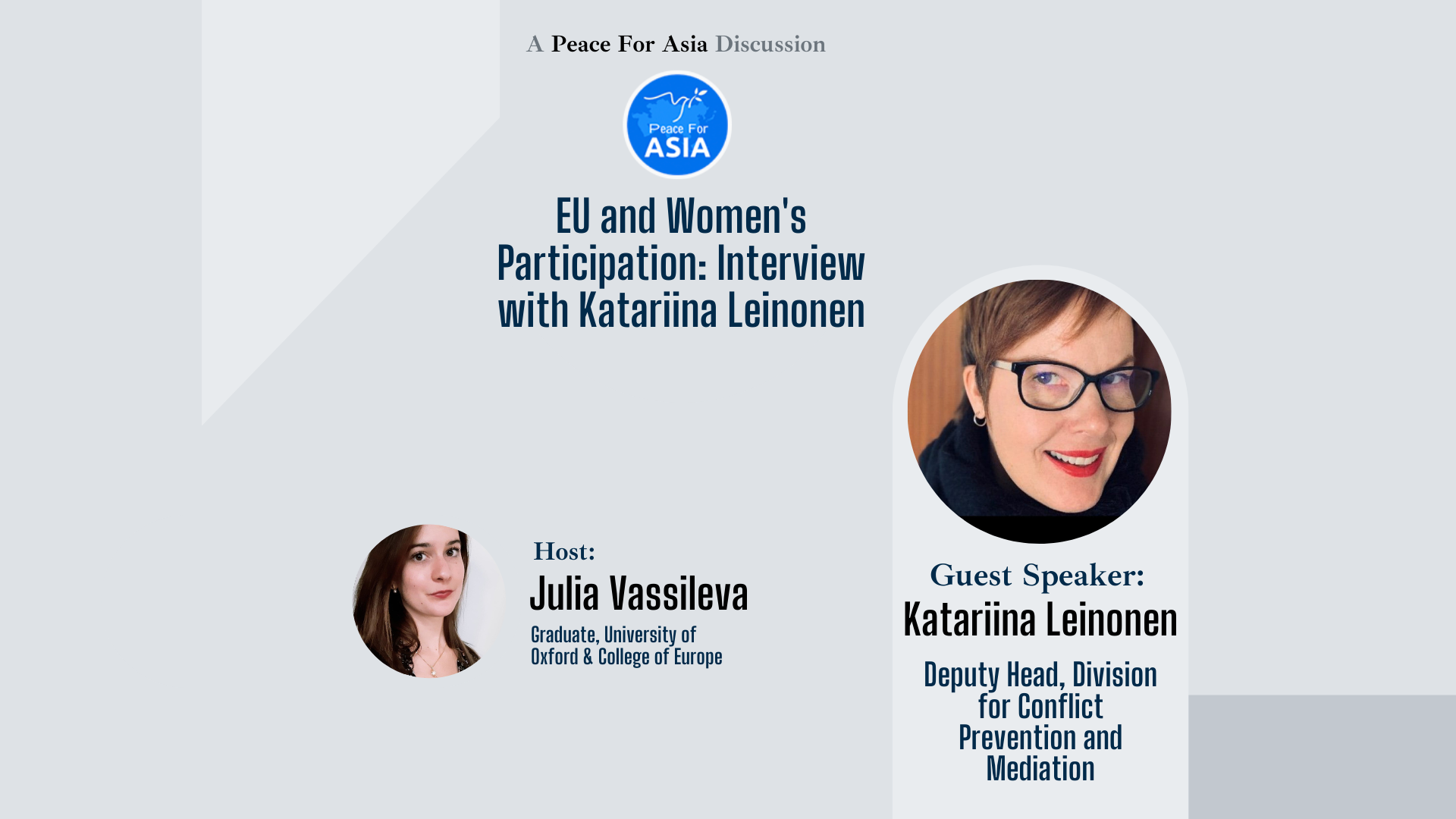She started her career with the EU in Burkina Faso where she worked for four years. Her next assignment included working in the capacity of Gender Focal point for what was then known as the European Commission for Development Cooperation. During her stint with the Geneva Directorate for External Relations, she played an instrumental role in the formulation of policy on women’s peace and security in 2008. She also worked in Rwanda working on the reconciliation efforts after the genocide. She served with the EU delegations in Venezuela and Tunisia. She is serving in her current position for over three years and is based out of Brussels. Specifically, she is dealing with peace mediation, besides coordinating work on gender, peace and security.

Peace for Asia interviewed Katariina Leiononen, Deputy Head, Division for Conflict Prevention and Mediation, European External Action Service.
EU’s initiatives for a greater role for women in Peace processes:
We have come a long way since the first policy on women was adopted on women by EU member states in 2008. This was known as Comprehensive Approach to UN Security Council Resolutions 1325 and 1820. The policy laid the groundwork for the EU’s evolving policy framework for women’s participation, protection and prevention. The participation was policy cuts across different dimensions of EU policy, especially women’s inclusion in policies and missions relating to EU external relations and the various projects funded by the EU.
If one looks at the Gender action plan, the current document we follow, the overarching framework is worth noting. During Federica Mogherini’s tenure as EU High Representative of the Union for Foreign Affairs and Security Policy, the EU made it mandatory to have 30 percent of beneficiaries as women in every policy discussion on peace and security.
It is important to highlight the 2020 EU concept on peace mediation, which was updated after 10 years that has an essential focus on women’s role in the process. The EU has ensured that it includes women in all the processes. We also have the peace mediation guidelines, which include a chapter on women’s inclusion.
Women’s involvement in peace processes:
Our experience during the negotiations in the Liberian conflict demonstrated the constructive role played by women, especially when they prevailed over their male counterparts in extracting the peace agreement. Essentially, women’s participation broadens the issues at stake and brings forth the societal questions that are integral to settlement in a post-conflict scenario. These issues go beyond post-conflict power-sharing or accountability and extend to fundamental issues like access to education, social services and women’s public participation. Women’s participation in these dialogues makes agreements more equitable and inclusive.
Challenges faced in the EU in formulating women-centrictric policies :
As several conflict sites are located outside the EU, its role has to be in the capacity of an external observer and a facilitator aiming at creating a conducive atmosphere for a peaceful settlement. In this capacity, the EU has to ensure that its intentions are rightly conveyed to the conflicting parties, especially with regard to cultural barriers to the inclusion of women in peace negotiations. There have been situations where women have been kept out or given a marginal role in peace negotiations. Therefore, the EU has to step in with its limitations as an external mediator to support women’s inclusion.
Another challenge is ensuring an environment where women feel safe discussing challenges. One has to consider practical issues within negotiations to provide those safe spaces anthe psychological support women would need to discuss sensitive issues like gender-based violence. We also face issues linked to women’s role in society.
Gender in Conflict Analysis:
Our division is supporting initiatives dealing with conflict analysis in more than 60 countries. Within the new Neighbourhood and Development cooperation instrument, there is a new requirement for having conflict analysis for all conflict-affected areas the EU is supporting. We are also implementing the flagship instrument on conflict prevention which is also known as the EU conflict early warning system. We have guidelines to ensure different elements are incorporated systematically and gender sensitivity is one of the guiding principles.
We are looking at how we should enforce our approach systematically. It is an ongoing process. This year we shall be working on upgrading our peace mediation guidelines, which enables us to incorporate new thinking and research on these topics to ensure efficiency and inclusion.
Ideas to support women’s inclusion in peace negotiation:
Interactions among women mediator networks from different networks have been instrumental in incorporating new approaches to mediation. For instance, communication among Nordic, MENA and African networks could be useful. Besides greater information sharing, these efforts would also encourage women who are either beginners in the field or hesitant to come forward
I would encourage more women in the field to seek these connections and exchanges and we must also encourage each other and never doubt the fact that the issues we bring forth might not merit attention. We must keep building these networks.
